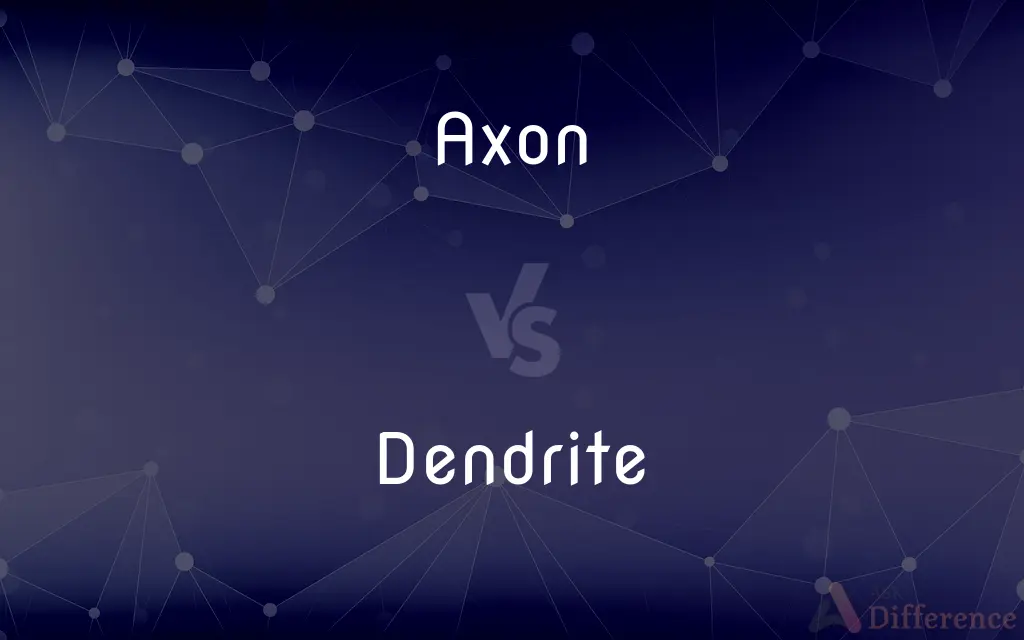Axon vs. Dendrite — What's the Difference?
By Maham Liaqat & Fiza Rafique — Updated on April 16, 2024
Axons transmit electrical signals away from the neuron's cell body, whereas dendrites receive these signals from other neurons.

Difference Between Axon and Dendrite
Table of Contents
ADVERTISEMENT
Key Differences
Axons are specialized for conducting electrical impulses away from the neuron's cell body, which is crucial for communicating with other neurons or muscles. In contrast, dendrites are designed to receive signals from the axons of other neurons, playing a key role in the input side of neural communication.
While axons are generally longer and can extend great distances from the cell body, dendrites tend to be shorter, with a branched tree-like structure that maximizes the surface area for receiving signals.
Axons are often myelinated, having a fatty sheath that speeds up the transmission of electrical signals along their length. Dendrites, on the other hand, lack this myelination, which influences the speed and efficiency of signal reception.
Each neuron typically has only one axon, which can branch but maintains the same basic function throughout its length. In contrast, a neuron can have many dendrites, each branching extensively to form complex networks for receiving multiple signals.
Axons often end in axon terminals, which are specialized to release neurotransmitters into the synaptic cleft. Dendrites, however, possess numerous receptor sites on their surfaces, designed to detect and respond to these chemical signals.
ADVERTISEMENT
Comparison Chart
Function
Transmits signals away from the cell body
Receives signals from other neurons
Length
Longer and can extend over great distances
Shorter and more localized
Structure
Generally singular with branches at the end
Highly branched throughout
Myelination
Commonly myelinated
Typically unmyelinated
Signal Direction
One-way (outgoing)
One-way (incoming)
Compare with Definitions
Axon
An axon is a long, slender projection of a nerve cell that typically conducts electrical impulses away from the neuron's cell body.
The axon of a motor neuron can be over a meter long, reaching from the spinal cord to the foot.
Dendrite
Dendrites are tree-like extensions at the beginning of a neuron that help in receiving signals from other neurons.
The dendrites were covered with synaptic inputs, showing their complex networking.
Axon
Each neuron has one axon that can branch into multiple axon terminals.
The axon terminals synapse with muscle fibers, controlling their contraction.
Dendrite
Dendrites play a crucial role in integrating synaptic inputs, which can influence neuronal output.
The overall activity of a neuron is significantly influenced by its dendritic input.
Axon
The axon hillock is the part of the neuron where the axon joins the cell body, crucial for initiating nerve signals.
A nerve impulse begins at the axon hillock.
Dendrite
Unlike axons, dendrites do not typically carry signals over long distances.
Dendrites handle the local processing of signals.
Axon
Axons are integral to the central nervous system, where they transmit signals rapidly across different parts of the body.
The axon's myelination helps increase the speed of signal transmission.
Dendrite
Dendritic spines are small protrusions that receive inputs from axons at synapses.
Each dendritic spine forms a synapse with an axon terminal.
Axon
In some diseases, such as multiple sclerosis, the myelin sheath of axons is damaged, affecting their function.
Damage to the axon's myelin sheath slows down signal transmission.
Dendrite
The structure of dendrites allows them to receive multiple signals simultaneously.
Dendritic trees branch out extensively to maximize contact with other neurons.
Axon
An axon (from Greek ἄξων áxōn, axis), or nerve fiber (or nerve fibre: see spelling differences), is a long, slender projection of a nerve cell, or neuron, in vertebrates, that typically conducts electrical impulses known as action potentials away from the nerve cell body. The function of the axon is to transmit information to different neurons, muscles, and glands.
Dendrite
Dendrites (from Greek δένδρον déndron, "tree"), also dendrons, are branched protoplasmic extensions of a nerve cell that propagate the electrochemical stimulation received from other neural cells to the cell body, or soma, of the neuron from which the dendrites project. Electrical stimulation is transmitted onto dendrites by upstream neurons (usually via their axons) via synapses which are located at various points throughout the dendritic tree.
Axon
The long threadlike part of a nerve cell along which impulses are conducted from the cell body to other cells.
Dendrite
A mineral crystallizing in another mineral in the form of a branching or treelike mark.
Axon
The usually long process of a nerve fiber that generally conducts impulses away from the body of the nerve cell.
Dendrite
A rock or mineral bearing such a mark or marks.
Axon
(cytology) A nerve fibre which is a long slender projection of a nerve cell, and which conducts nerve impulses away from the body of the cell to a synapse.
Dendrite
A branched protoplasmic extension of a nerve cell that conducts impulses from adjacent cells inward toward the cell body. A single nerve may possess many dendrites. Also called dendron.
Axon
Long nerve fiber that conducts away from the cell body of the neuron
Dendrite
(cytology) A slender projection of a nerve cell which conducts nerve impulses from a synapse to the body of the cell; a dendron.
Dendrite
(cytology) Slender cell process emanating from the cell bodies of dendritic cells and follicular dendritic cells of the immune system.
Dendrite
Tree-like structure of crystals growing as material crystallizes
Dendrite
A hermit who lived in a tree
Dendrite
A stone or mineral on or in which are branching figures resembling shrubs or trees, produced by a foreign mineral, usually an oxide of manganese, as in the moss agate; also, a crystallized mineral having an arborescent form, e. g., gold or silver; an arborization.
Dendrite
Short fiber that conducts toward the cell body of the neuron
Common Curiosities
What distinguishes the structure of axons from dendrites?
Axons are typically longer, less branched until their terminations, and often myelinated, whereas dendrites are shorter, highly branched, and unmyelinated.
What is the primary function of an axon?
The primary function of an axon is to transmit electrical impulses away from the neuron's cell body.
How do dendrites contribute to neural functioning?
Dendrites receive and integrate signals from other neurons, contributing to the decision-making process of whether the neuron will fire a signal through its axon.
What happens when axons are damaged?
Damage to axons can disrupt the transmission of signals within the nervous system, leading to various neurological symptoms.
Can dendrites generate electrical signals?
While dendrites mainly receive signals, certain types can generate electrical signals, particularly during complex synaptic integrations.
Do all neurons have both axons and dendrites?
Most neurons have both, but some neuron types may lack dendrites or have axons that perform both input and output functions.
How do axons and dendrites work together in a neuron?
Axons and dendrites work together to transmit and receive information, respectively, allowing neurons to communicate effectively within neural circuits.
Why are axons sometimes myelinated?
Myelination of axons helps increase the speed of electrical signal transmission, allowing for faster communication between distant parts of the nervous system.
What are the clinical implications of axonal damage?
Axonal damage can lead to severe impairments in movement, sensation, or cognitive functions, depending on which part of the nervous system is affected.
Can the length of dendrites vary between different types of neurons?
Yes, the length and branching of dendrites can vary widely, reflecting the specific input needs and integration complexity of different neuron types.
How does the structure of axons and dendrites affect their function?
The structure directly influences their function: axons are optimized for fast signal transmission over distances, while dendrites are optimized for signal reception and integration.
Are axon terminals and dendritic spines structurally similar?
No, axon terminals are designed to release neurotransmitters, whereas dendritic spines are structured to receive and respond to these chemicals.
How does myelination affect dendrites?
Dendrites are typically not myelinated; their function involves the local processing of incoming signals, which does not require the rapid transmission provided by myelination.
What is the role of the axon hillock?
The axon hillock is crucial for initiating nerve impulses, determining whether the neuronal conditions are sufficient to generate a signal.
Can dendrites affect the behavior of a neuron?
Yes, dendrites play a crucial role in determining the neuronal output by integrating various synaptic inputs.
Share Your Discovery

Previous Comparison
Bounce vs. Bound
Next Comparison
Executive vs. LegislativeAuthor Spotlight
Written by
Maham LiaqatCo-written by
Fiza RafiqueFiza Rafique is a skilled content writer at AskDifference.com, where she meticulously refines and enhances written pieces. Drawing from her vast editorial expertise, Fiza ensures clarity, accuracy, and precision in every article. Passionate about language, she continually seeks to elevate the quality of content for readers worldwide.














































